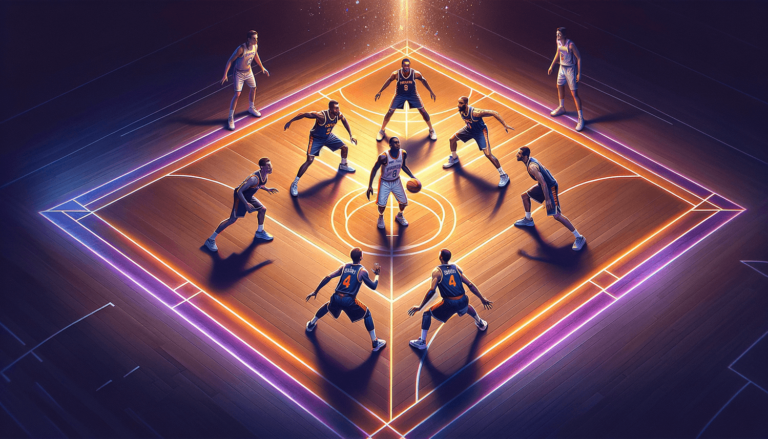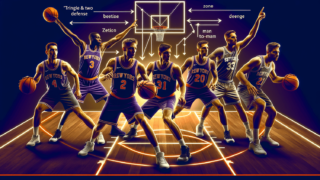
What’s a Diamond and One Defense in Basketball?
Written by: Basketball Universe
Last updated:

Curious about the ins and outs of basketball defense strategies? You’re in the right place! In today’s blog post, we’ll explore the lesser-known, yet dazzlingly effective, diamond and one defense. Often compared to sparkling gemstones in the world of basketball, this intriguing defensive setup might be the key to shutting down your opponents. So, grab your sneakers and get ready to weave through an intricate web of basketball knowledge, as we uncover the magic behind the diamond and one defense.
What’s a Diamond and One Defense in Basketball?
A Diamond and One Defense in basketball is a hybrid defensive strategy that combines elements of both zone and man-to-man defense. Four players form a diamond-shaped zone on the court, while the fifth player is assigned to closely guard the opponent’s primary scorer. This setup allows the team to limit the scoring opportunities of the star player, while also maintaining pressure on the rest of the opposing team.
The Sparkling Origins of the Diamond and One Defense
In the gleaming world of basketball, tactical masterminds are always on the hunt for innovative ways to counter their opponents. Enter the diamond and one defense, a brilliant mix of both zone and man-to-man defense that shines bright in the strategic playbook. Though its origins are not entirely clear, this defense has gained traction over time, primarily implemented against teams with a lethal scoring superstar. Now let’s dive in and dissect the mesmerizing mechanics of the diamond and one defense. We’ll explore its strengths, weaknesses, and practical applications—enlightening you on this bedazzling basketball secret.
The Glistening Fundamentals
Understanding the Formation
The name “diamond and one” aptly describes the formation itself: four players arrange themselves to form a diamond-shaped zone, while the fifth player tightly guards the primary scoring threat. The diamond configuration ensures pressure is exerted over the court, with one player positioned at the top (point guard), two players at the wings (small forward and shooting guard), and the final player down low (center). This player distribution makes it difficult for the opposing team to find open shots, penetrate the paint, or execute fast breaks, thus neutralizing their overall offensive prowess.
Executing the Defense
Once the diamond formation is set, the key to effectively implementing the diamond and one defense lies in communication and agility. Players must maintain ample physical and mental alertness — employing quick switches, rotating strategically, and recognizing potential scoring threats. The top, wing, and low players must continuously monitor their zones, while the fifth player (often a lockdown defender) tirelessly shadows the opponent’s key scorer. This relentless pressure helps disrupt the opposition’s usual offensive rhythm, making it challenging for the star player to rack up points.
Unlocking the Diamond’s Potential
When to Deploy
The diamond and one defense shines the brightest (pun intended) when deployed against teams with a single dominant scorer. By specifically targeting such superstars, the defense forces the supporting cast to step up and bear the offensive burden—a pressure they might not be accustomed to. Frequently deployed as a surprise tactic in crucial moments, the diamond and one can throw the opposition off balance and allow for crucial momentum shifts within a game.
Transitioning In and Out
To capitalize on the diamond and one defense’s effectiveness fully, teams should be adept at seamlessly transitioning between this special formation and other traditional defenses. Adopting this strategy from the start could expose its weaknesses and render it less potent. Instead, its surprise element when alternated with steady man-to-man or zone defense can yield optimal results, catching opponents off guard and maximizing disruption.
Fending Off the Sparkle: Counter Tactics
Offensive Adjustments
Understanding how to crack the diamond and one defense is crucial for any basketball-savvy playmaker. A key adjustment is to involve the primary scorer more actively in playmaking, allowing them to find open teammates through clever off-the-ball movement and crisp passing. Moreover, teams should focus on executing pinpoint screens to create open opportunities for their star player or using quick inside-out ball movement to exploit gaps in the defensive formation.
Breaking the Zone
Since the diamond and one defense is reliant on its zone structure, targeting and breaking the zone becomes a priority. Realigning players to exploit weaknesses in the defense’s formation or employing sharpshooting specialists to sink long-range shots can stretch the diamond thin, negating its impact. Additionally, teams can employ a high-tempo offense and rapid ball movement to throw the diamond off balance, forcing defenders out of position and creating open spaces to exploit.
Teams That Shined with Diamond and One Defense
Several notable teams and coaches have harnessed the glittering power of the diamond and one defense over basketball history. From high school basketball to the professional stage, its tactical effectiveness has been felt around the sport. Let’s look at some instances where the diamond and one defense wowed crowds and frustrated opponents:
John Chaney’s Temple Owls
Hall of Fame coach John Chaney and his Temple Owls basketball teams were renowned for their deployment of the diamond and one defense. With strong execution and cohesive communication, Chaney’s teams were renowned for their fierce defensive intensity, frequently limiting opposing stars to minimal impact and capturing crucial wins as a result.
The Golden State Warriors
During the 2019 NBA Finals, the Golden State Warriors leveraged an unlikely savior in the diamond and one defense. Facing a Toronto Raptors team led by the unstoppable Kawhi Leonard, the Warriors caught their opponents off-guard with the unique strategy, helping to secure a vital win in game two of the series. Although it wasn’t enough to win the championship, adopting the diamond and one in a clutch moment showcased the defense’s potential when appropriately applied.
Polishing Your Skills: Tips for Mastering the Diamond and One Defense
With a newfound appreciation for the diamond and one defense, you might be itching to implement it in your own basketball repertoire. To ensure you sparkle on the court, here are some essential tips for mastering this bedazzling defensive scheme:
Communication is Key
Cultivating strong communication among the players is essential for this defense to work. Quick, effective communication allows defenders to anticipate offensive moves, rotate efficiently, and maintain seamless defensive pressure. Regularly practicing these interactions will foster enhanced defensive awareness and overall success.
Agility and Anticipation
The diamond and one demands physical and mental agility from defenders, tasking them with rapid, on-court decision-making. Performing drills to enhance speed, strength, and flexibility will prove invaluable in elevating your defensive prowess, helping you anticipate plays and react with lightning reflexes worthy of this shimmering scheme.
Smart Switches and Rotations
Efficient switching and strategic rotations to close gaps quickly are the backbone of the diamond and one defense. Scrutinize game footage and conduct regular practice to identify the optimal switches and rotations, transforming your team into a sparkling defensive unit that dazzles foes and solidifies victories.
With a comprehensive understanding of the diamond and one defense settled like shining gems in your basketball toolbox, you’re now equipped to conquer the court with a revitalized defensive edge. Whether utilized as a surprise tactic or deployed to stifle elite scorers, this mesmerizing defense showcases the importance of innovation, adaptability, and tactical mastery in the radiant realm of basketball.
Shattering the Diamond: Potential Weaknesses
As with any defensive scheme, the diamond and one defense is not without weaknesses. A well-prepared team willing to adapt their offense can exploit these vulnerabilities and dismantle the diamond’s effectiveness. The following are some areas of concern you should be aware of when employing the diamond and one defense:
Reliance on a Lockdown Defender
A key component of the diamond and one defense is the responsibility of a single defender to guard the opposing team’s primary scorer. If your team lacks a dedicated lockdown defender, the diamond and one may falter, as the star player breaks free and easily scores.
Rebounding and Second-Chance Opportunities
The diamond and one defense tends to stretch the zone, resulting in suboptimal positioning for rebounds. Opposing teams may capitalize on this weakness by capturing offensive boards and scoring second-chance points. To counteract this, the frontcourt players (center and forwards) must remain vigilant and make a concerted effort to secure the rebound upon the first shot attempt by the offense.
Adjusting to Offense’s Pacing and Playstyle
Successfully implementing the diamond and one defense will require your team to adapt to the offense’s pace and playstyle. Teams that can speed up the game with fast breaks, ball movement, and passing might break the diamond if the defense can’t keep up with the tempo.
Drills to Fortify Your Diamond and One Defense
Transforming your team into an effective diamond and one defensive machine requires consistent practice, simulating various game scenarios, and perfecting essential skills. To help you on this journey, incorporate the following drills into your practice sessions:
Shell Drill
The classic shell drill is an excellent workout for building essential defensive habits, including quick closeouts, active hands, and maintaining a defensive stance. To adapt the shell drill to the diamond and one defense, assign each player to their respective zones and direct them to switch positions and rotate as a cohesive unit, mirroring actual in-game movements.
Defensive Transition Drill
Defensive transition drills teach defenders to get back on defense quickly and assume their roles in the diamond formation after a missed shot. These drills are vital for developing the necessary speed and awareness to slice through offensive counterattacks while returning to the diamond structure.
One-on-One Lockdown Defender Exercise
For the individual defender assigned to guard the primary scorer, one-on-one isolation drills can significantly hone defensive skills. These drills concentrate on enhancing foot speed, maintaining a low stance, and developing anticipation by predicting the offense’s movement.
By tackling these weaknesses head-on and consistently training your team with specific drills, you can ensure that the diamond and one defense maintains its luster, allowing you to shut down opposing offenses and claim victory on the basketball court.
FAQ: Diamond and One Defense Questions Answered
Still curious about the glittering world of the diamond and one defense? Check out our comprehensive FAQ section, where we tackle some of the most pressing questions surrounding this intriguing defensive strategy. Explore your inquisitive side and elevate your understanding of the diamond and one defense in basketball.
1. What is the purpose of the diamond and one defense?
The diamond and one defense aims to limit the impact of the opposing team’s primary scorer while maintaining pressure on other players through a diamond-shaped zone defense.
2. When should a team use the diamond and one defense?
A team should use the diamond and one defense when facing an opponent with a dominant scorer as at least one player is dedicated to closely guarding their primary scoring threat.
3. How does the diamond and one defense differ from other defensive strategies?
Unlike traditional man-to-man or zone defenses, the diamond and one defense is a hybrid setup that combines zone defense (four players in a diamond formation) with man-to-man defense (one player guarding the primary scorer).
4. Can the diamond and one work against teams without a prominent superstar?
While the diamond and one defense may still work against teams without a dominant scorer, it is less effective since its primary strength lies in shutting down a primary offensive threat while maintaining zone pressure on other players.
5. Which basketball teams are known for using the diamond and one defense?
Historically, John Chaney’s Temple Owls and the Golden State Warriors are two notable examples of teams that have employed the diamond and one defense effectively.
6. What drills can help to improve a team’s diamond and one defensive skills?
Shell drills, defensive transition drills, and one-on-one lockdown defender exercises are excellent for developing the necessary skills to execute the diamond and one defense effectively.
7. What are the main weaknesses of the diamond and one defense?
Significant weaknesses of the diamond and one defense include reliance on a lockdown defender, vulnerability to offensive rebounds and second-chance points, and difficulty in adapting to the offense’s pace and playstyle.
8. How can an offense counteract the diamond and one defense?
An offense can counteract the diamond and one defense by involving the primary scorer in playmaking, executing precise screens, and employing swift ball movement to break the zone.
9. How can a team transition effectively between the diamond and one defense and other defensive strategies during a game?
Effective transitioning requires frequent practice, well-established player communication, and a solid understanding of both the diamond and one defense and other defensive strategies, ensuring seamless switching during games.
10. Can the diamond and one defense be applied to other sports?
Although tailored to basketball, the diamond and one defense’s principles can be adapted to fit other sports with individual scoring threats and considerable emphasis on guarding specific zones.
11. How does the diamond and one defense work against fast-break offenses?
The diamond and one defense may struggle against fast-break offenses if the defenders are unable to keep pace with rapid offensive advances while maintaining the zone structure.
12. How important is height and size in the diamond and one defense?
Height and size can be advantageous for teams utilizing the diamond and one defense, but the strategy’s success often hinges on agility, speed, versatility, and strong communication among defenders.
13. Are there any variations of the diamond and one defense?
Although the diamond and one defense primarily consists of four players in a diamond-shaped zone and one player guarding the primary scoring threat, coaches may modify the formation or positioning to fit their team’s strengths or counter specific offensive strategies.
Featured Posts
- No pillar pages found.





